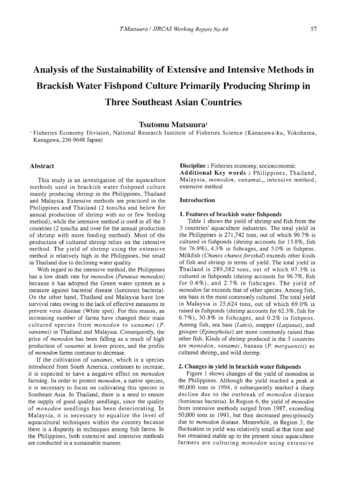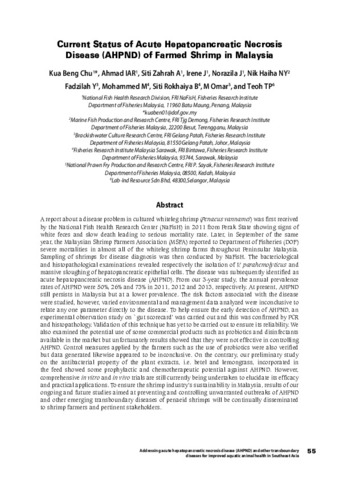Biofloc-based nursery production system: Heeding the call towards a sustainable shrimp culture industry in the Philippines
| dc.contributor.author | Caipang, Christopher Marlowe | |
| dc.contributor.author | Trebol, Kathleen Mae P. | |
| dc.contributor.author | Fagutao, Fernand | |
| dc.contributor.author | Pakingking, Rolando V., Jr. | |
| dc.contributor.author | Deocampo, Joel E., Jr. | |
| dc.date.accessioned | 2022-05-16T06:46:51Z | |
| dc.date.available | 2022-05-16T06:46:51Z | |
| dc.date.issued | 2022 | |
| dc.identifier.citation | Caipang, C. M., Trebol, K. M. P., Fagutao, F., Pakingking, R., & Deocampo Jr., J. E. (2022). Biofloc-based nursery production system: Heeding the call towards a sustainable shrimp culture industry in the Philippines. International Journal of Biosciences, 20(3), 250-259. | en |
| dc.identifier.issn | 2220-6655 | |
| dc.identifier.uri | http://hdl.handle.net/10862/6322 | |
| dc.description.abstract | The increasing global population resulted in intense pressure on the food production sectors to meet the rise in food demand. The aquaculture industry, which is one of the major food production sectors, provides opportunities in addressing issues on malnutrition and poverty alleviation. Shrimp farming is an important sub-sector in aquaculture because shrimp are not only good sources of food, but they contribute to the national economy through export revenues. This resulted in the rapid intensification of shrimp aquaculture, which created negative issues on sustainability and environmental impacts. Hence, this necessitates an urgent need to develop aquaculture production systems that yield high productivity and profitability yet possess a low carbon footprint. Biofloc technology (BFT) fit into these criteria as this technology permits intensive culture of aquatic species, less use of resources, and improved water quality as a consequence of the production and activity of beneficial microbial biomass, which, at the same time, can be utilized as a source of feed for the growing shrimp. BFT has been shown to be successful on a commercial scale during shrimp grow-out, and recent studies have shown that this technology can be further refined and optimized for the production of shrimp during the nursery phase. This review, therefore, highlights the basics of BFT and how this technology is being optimized in the production of shrimp during the nursery phase. More specifically, this discusses the benefits of this approach in ensuring a productive yet sustainable way of producing shrimp in the context of Philippine aquaculture. | en |
| dc.description.sponsorship | This research study is part of the project, “Bioflocbased Nursery Tank Production of Shrimp for Quality and Sustainable Supply of Aquaculture Products in the New Normal” funded by the Department of Science and Technology (DOST) through the Science for Change Program (S4CP) – Collaborative Research and Development to Leverage Philippine Economy (CRADLE) and monitored by DOST – Philippine Council for Agriculture, Aquatic and Natural Resources Research and Development (PCAARRD) with Project Number 8444 awarded to CMA Caipang. The authors gratefully acknowledge the support provided by the University of San Agustin and Marmi Agricultural Corporation. | en |
| dc.language.iso | en | en |
| dc.publisher | International Network for Natural Sciences | en |
| dc.relation.uri | https://www.innspub.net/wp-content/uploads/2022/06/IJB-V20-No3-p250-259.pdf | en |
| dc.subject | Philippines | en |
| dc.subject | Penaeus vannamei | en |
| dc.title | Biofloc-based nursery production system: Heeding the call towards a sustainable shrimp culture industry in the Philippines | en |
| dc.type | Article | en |
| dc.identifier.doi | 10.12692/ijb/20.3.250-259 | |
| dc.citation.volume | 20 | |
| dc.citation.issue | 3 | |
| dc.citation.spage | 250 | |
| dc.citation.epage | 259 | |
| dc.citation.journalTitle | International Journal of Biosciences | en |
| dc.subject.asfa | biofloc technology | en |
| dc.subject.asfa | shrimp culture | en |
| dc.subject.asfa | aquaculture | en |
| dc.subject.asfa | aquaculture systems | en |
| dc.subject.asfa | organic carbon | en |
| dc.identifier.essn | 2222-5234 | |
| dc.subject.scientificName | Litopenaeus vannamei | en |
| dc.subject.scientificName | Penaeus vannamei | en |
| local.subject | Aquatic | en |
| local.subject | Aquaculture | en |
| local.subject | Environment | en |
| local.subject | Litopenaeus vannamei | en |
| local.subject | Microbial flocs | en |
このアイテムのファイル
| ファイル | サイズ | フォーマット | 閲覧 |
|---|---|---|---|
|
このアイテムに関連するファイルは存在しません。 |
|||
このアイテムは次のコレクションに所属しています
-
Journal Articles [1256]
These papers were contributed by Department staff to various national and international journals.



